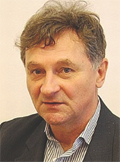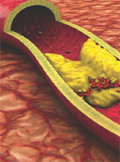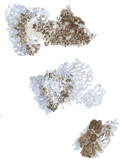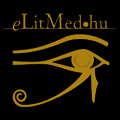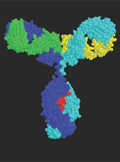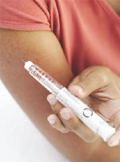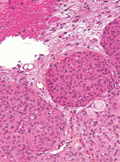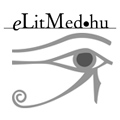The eLitMed.hu medical portal uses computer cookies for convenient operation. Detailed information can be found in the Cookie-policy.
Lege Artis Medicinae - 2013;23(10-11)
Content
[Cardiovascular risk factors and risk assessment]
[The author summarises the most important cardiovascular risk factors. Concerning public health, the three most important synergistic factors are smoking, hypertension and abnormal cholesterol. Abnormal total lipid profile, visceral obesity, elevated glucose and uric acid levels and hypertonia all contribute to the global cardiometabolic risk. A number of studies and metaanalyses have confirmed the correlations of the risk factors and cardiovascular events (organ damage, clinical events, mortality). The concomitant occurance of risk factors increases the rate of risk. Risk estimation methods have been designed on the basis of proven correlations and they have been continuously improved and made more reliable owing to the assessment of more and more factors.]
[Therapeutic options for the treatment of neuroendocrine tumors]
[This paper provides an overview of the latest clinical advances regarding state-of-theart treatment of neuroendocrine tumours. The first-line treatment of any localized neuroendocrine tumour is surgical removal of the tumour. The only exceptions are certain small gastric carcinoids and small, hormonally inactive pancreatic tumours associated with multiple endocrine neoplasia type I. The treatment strategies of disseminated neuroendocrine tumours should be based on a pathological diagnosis that uses the 2010 WHO classification (neuroendocrine tumours G1 and G2, neuroendocrine carcinoma G3). Debulking surgery and radiofrequency ablation can be used effectively not only as an anti-tumour treatment but also in patients with severe symptoms and hormone overproduction resistant to treatment. The use of somatostatin-analogs is considered to be standard treatment in functional neuroendocrine tumours of any origin, as well as in the anti-tumour therapy of G1/G2 small intestinal neuroendocrine tumours. For progressive G1-G2 neuroendocrine pancreatic tumours, streptozocin-based combined chemotherapy is the first-line treatment. Targeted drug therapies, such as mTOR inhibitors and tyrosine kinase inhibitors are used as second- or third-line agents in patients with inoperable pancreatic neuroendocrine tumours. Peptide receptor radiotherapy is increasingly used in Europe; however, its final place amongst other therapeutic modalities remains to be investigated.]
[Therapeutic strategies in rheumatoid arthritis]
[In this review, we follow the consecutive steps of the internationally accepted therapeutic strategy of rheumatoid arthritis (RA). We summarise in brief the current European recommendations, and provide some advice on methotrexate (MTX) therapy. The initiation, maintenance and, if needed, switch of biological therapy is also discussed. Having reached remission or low disease activity (LDA), tapering or discontinuation of biologics may be considered. Finally, we review the possibilities and the most important biomarkers of personalised treatment.]
[The possibilities and practice of immunoglobulin replacement in adults with antibody deficiency]
[Primary antibody deficiencies can occur at any age, but in a significant number of patients the correct diagnosis has not been established yet and thus their treatment has not been initiated. In patients with primary antibody deficiency, lifelong immunoglobulin replacement therapy has no alternatives. Immunoglobulin replacement therapy applied at adequate doses can prevent infections and provide a good quality of life for patients. In addition to intravenous preparations that have been used for decades, new preparations for subcutaneous administration are available now in Hungary as well. Subcutaneous preparations have fewer systemic side effects, can be used at home and, with weekly infusions, can provide more constant IgG levels, which can be beneficial in preventing infections.]
[Titration of insulin glargin in type 2 diabetic patients treated with oral agents and with necessity of basal insulin in everyday medical practice ]
[INTRODUCTION - Early insulin treatment is a widely accepted option for combination glucose-lowering therapy, and its most common form is basal insulin supported oral therapy (BOT). Due to its 24-hour action and lack of peaks in plasma insulin concentrations, insulin glargine is an ideal choice for BOT. METHODS - We conducted a prospective, non-interventional study to evaluate the efficiency and safety of dose titration, the period of time necessary to reach the target fasting blood glucose level, and the changes in glargine insulin dose. The study group included patients with type 2 diabetes who had been treated with insulin glargine in BOT regimen for no longer than four weeks. The follow-up period was six months. RESULTS - During the study period, the mean fasting plasma glucose was decreased from 9.8 mmol/L to 6.7 mmol/L, the mean HbA1c level decreased from 8.8% to 7.3%, and the mean postprandial glucose level decreased from 11.5 mmol/L to 8.2 mmol/L. Mild hypoglycaemic episodes occurred in 6.5% of patients in the first 3 months and in 6.9% of patients between months 3 and 6. During the same periods, severe hypoglycaemic episodes occurred in 0.08% and 0.17% of patients, respectively. Both mean body weight and mean BMI decreased during the study period. The average daily dose of glargine continuously increased during the observation period from baseline 10.42 IU to 17.69 IU. DISCUSSION - In the study population, glargine therapy in BOT regimen significantly improved glycaemic control, while a slight but statistically significant reduction was observed in the patients’ body weight. The daily dose of insulin glargine increased during titration, and the therapy proved to be safe.]
[Who are the happy female physicians in Hungary?]
[BACKGROUND - The female Physicians’ well-being and happiness has become the latest researching field of the “Physicians studies”. In Hungary the researches haven't focused on this subject. Our aim was to examine the subjective well-being of the Hungarian female Physicians. METHODS - Representative, cross-sectional, quantitative survey on a representative sample of female Physicians (N=408). Modified version of WHO Well- Being Index was performed to measure of subjective Well-Being. RESULTS - We have found that the key to the Hungarian female Physicians’ wellbeing is the “time”. Significantly higher rate of well-being is associated with reduced work-hours (8 hour or less, p=0.000), and duty hours (p=0.042), having one hour free time daily (p=0.021) and they satisfied with the time of doctor-patient interaction (p=0.021). The higher rate of Well-Being scores haven't associated with age, marital status, number of children and the speciality. CONCLUSION - Similarly to the national trends, the Hungarian female Physicians' well-being is depending on the work and the satisfaction with work. The satisfied healer is the key of the health system therefore the future studies and the prevention and intervention have to focus on the Physicians’ well-being.]
1.
Clinical Neuroscience
Is there any difference in mortality rates of atrial fibrillation detected before or after ischemic stroke?2.
Clinical Neuroscience
Factors influencing the level of stigma in Parkinson’s disease in western Turkey3.
Clinical Neuroscience
Neuropathic pain and mood disorders in earthquake survivors with peripheral nerve injuries4.
Journal of Nursing Theory and Practice
[Correlations of Sarcopenia, Frailty, Falls and Social Isolation – A Literature Review in the Light of Swedish Statistics]5.
Clinical Neuroscience
[Comparison of pain intensity measurements among patients with low-back pain]1.
Clinical Neuroscience Proceedings
[A Magyar Stroke Társaság XVIII. Kongresszusa és a Magyar Neuroszonológiai Társaság XV. Konferenciája. Absztraktfüzet]2.
3.
Journal of Nursing Theory and Practice
[A selection of the entries submitted to the literary contest "Honorable mission: the joys and challenges of our profession" ]4.
Journal of Nursing Theory and Practice
[End of Life and Palliative Care of Newborns in the Nursing Context]5.
Journal of Nursing Theory and Practice
[Aspects of Occupational Health Nursing for Incurable Patients ]